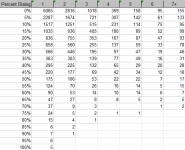iwatchus
Older than that
- Joined
- Sep 12, 2015
- Posts
- 2,356
But I think this largely matches the reader's perception looking at the page.I see this as being an issue with trying to do this analysis on anything I've written, because I was taught that new dialogue means a new paragraph. So
"Yes?"
"Yes, what?" His voice was low and commanding.
"Yes, sir."
"That's better."
Is now 4 paragraph, with 100% dialogue per paragraph. But any other equally long string of words would probably be 1 paragraph.

